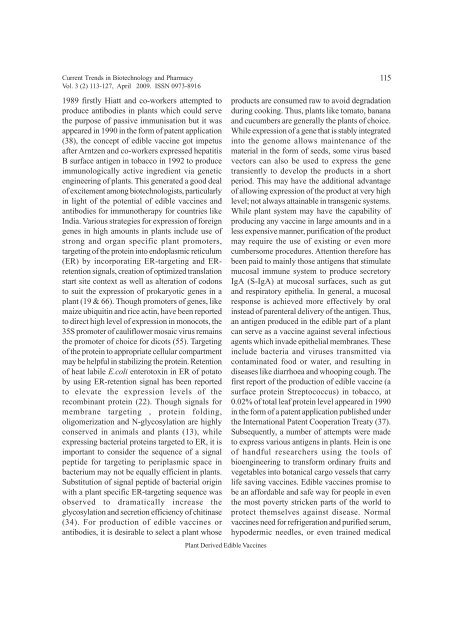April Journal-2009.p65 - Association of Biotechnology and Pharmacy
April Journal-2009.p65 - Association of Biotechnology and Pharmacy
April Journal-2009.p65 - Association of Biotechnology and Pharmacy
You also want an ePaper? Increase the reach of your titles
YUMPU automatically turns print PDFs into web optimized ePapers that Google loves.
Current Trends in <strong>Biotechnology</strong> <strong>and</strong> <strong>Pharmacy</strong><br />
Vol. 3 (2) 113-127, <strong>April</strong> 2009. ISSN 0973-8916<br />
115<br />
1989 firstly Hiatt <strong>and</strong> co-workers attempted to<br />
produce antibodies in plants which could serve<br />
the purpose <strong>of</strong> passive immunisation but it was<br />
appeared in 1990 in the form <strong>of</strong> patent application<br />
(38), the concept <strong>of</strong> edible vaccine got impetus<br />
after Arntzen <strong>and</strong> co-workers expressed hepatitis<br />
B surface antigen in tobacco in 1992 to produce<br />
immunologically active ingredient via genetic<br />
engineering <strong>of</strong> plants. This generated a good deal<br />
<strong>of</strong> excitement among biotechnologists, particularly<br />
in light <strong>of</strong> the potential <strong>of</strong> edible vaccines <strong>and</strong><br />
antibodies for immunotherapy for countries like<br />
India. Various strategies for expression <strong>of</strong> foreign<br />
genes in high amounts in plants include use <strong>of</strong><br />
strong <strong>and</strong> organ specific plant promoters,<br />
targeting <strong>of</strong> the protein into endoplasmic reticulum<br />
(ER) by incorporating ER-targeting <strong>and</strong> ERretention<br />
signals, creation <strong>of</strong> optimized translation<br />
start site context as well as alteration <strong>of</strong> codons<br />
to suit the expression <strong>of</strong> prokaryotic genes in a<br />
plant (19 & 66). Though promoters <strong>of</strong> genes, like<br />
maize ubiquitin <strong>and</strong> rice actin, have been reported<br />
to direct high level <strong>of</strong> expression in monocots, the<br />
35S promoter <strong>of</strong> cauliflower mosaic virus remains<br />
the promoter <strong>of</strong> choice for dicots (55). Targeting<br />
<strong>of</strong> the protein to appropriate cellular compartment<br />
may be helpful in stabilizing the protein. Retention<br />
<strong>of</strong> heat labile E.coli enterotoxin in ER <strong>of</strong> potato<br />
by using ER-retention signal has been reported<br />
to elevate the expression levels <strong>of</strong> the<br />
recombinant protein (22). Though signals for<br />
membrane targeting , protein folding,<br />
oligomerization <strong>and</strong> N-glycosylation are highly<br />
conserved in animals <strong>and</strong> plants (13), while<br />
expressing bacterial proteins targeted to ER, it is<br />
important to consider the sequence <strong>of</strong> a signal<br />
peptide for targeting to periplasmic space in<br />
bacterium may not be equally efficient in plants.<br />
Substitution <strong>of</strong> signal peptide <strong>of</strong> bacterial origin<br />
with a plant specific ER-targeting sequence was<br />
observed to dramatically increase the<br />
glycosylation <strong>and</strong> secretion efficiency <strong>of</strong> chitinase<br />
(34). For production <strong>of</strong> edible vaccines or<br />
antibodies, it is desirable to select a plant whose<br />
Plant Derived Edible Vaccines<br />
products are consumed raw to avoid degradation<br />
during cooking. Thus, plants like tomato, banana<br />
<strong>and</strong> cucumbers are generally the plants <strong>of</strong> choice.<br />
While expression <strong>of</strong> a gene that is stably integrated<br />
into the genome allows maintenance <strong>of</strong> the<br />
material in the form <strong>of</strong> seeds, some virus based<br />
vectors can also be used to express the gene<br />
transiently to develop the products in a short<br />
period. This may have the additional advantage<br />
<strong>of</strong> allowing expression <strong>of</strong> the product at very high<br />
level; not always attainable in transgenic systems.<br />
While plant system may have the capability <strong>of</strong><br />
producing any vaccine in large amounts <strong>and</strong> in a<br />
less expensive manner, purification <strong>of</strong> the product<br />
may require the use <strong>of</strong> existing or even more<br />
cumbersome procedures. Attention therefore has<br />
been paid to mainly those antigens that stimulate<br />
mucosal immune system to produce secretory<br />
IgA (S-IgA) at mucosal surfaces, such as gut<br />
<strong>and</strong> respiratory epithelia. In general, a mucosal<br />
response is achieved more effectively by oral<br />
instead <strong>of</strong> parenteral delivery <strong>of</strong> the antigen. Thus,<br />
an antigen produced in the edible part <strong>of</strong> a plant<br />
can serve as a vaccine against several infectious<br />
agents which invade epithelial membranes. These<br />
include bacteria <strong>and</strong> viruses transmitted via<br />
contaminated food or water, <strong>and</strong> resulting in<br />
diseases like diarrhoea <strong>and</strong> whooping cough. The<br />
first report <strong>of</strong> the production <strong>of</strong> edible vaccine (a<br />
surface protein Streptococcus) in tobacco, at<br />
0.02% <strong>of</strong> total leaf protein level appeared in 1990<br />
in the form <strong>of</strong> a patent application published under<br />
the International Patent Cooperation Treaty (37).<br />
Subsequently, a number <strong>of</strong> attempts were made<br />
to express various antigens in plants. Hein is one<br />
<strong>of</strong> h<strong>and</strong>ful researchers using the tools <strong>of</strong><br />
bioengineering to transform ordinary fruits <strong>and</strong><br />
vegetables into botanical cargo vessels that carry<br />
life saving vaccines. Edible vaccines promise to<br />
be an affordable <strong>and</strong> safe way for people in even<br />
the most poverty stricken parts <strong>of</strong> the world to<br />
protect themselves against disease. Normal<br />
vaccines need for refrigeration <strong>and</strong> purified serum,<br />
hypodermic needles, or even trained medical













